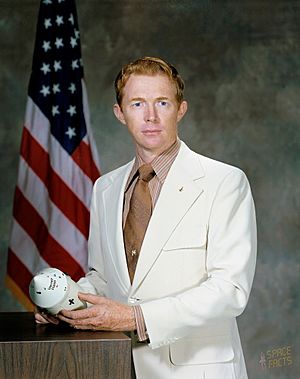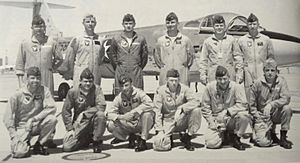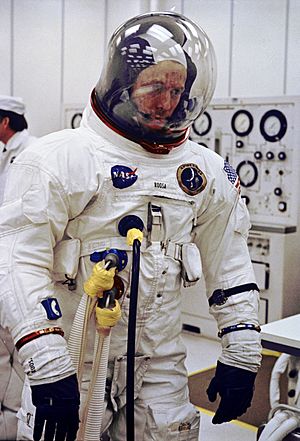Stuart Roosa facts for kids
Quick facts for kids
Stuart A. Roosa
|
|
|---|---|

Roosa in 1971
|
|
| Born |
Stuart Allen Roosa
August 16, 1933 Durango, Colorado, U.S.
|
| Died | December 12, 1994 (aged 61) Falls Church, Virginia, U.S.
|
| Resting place | Arlington National Cemetery |
| Nationality | American |
| Alma mater | Oklahoma State University, Stillwater (attended) University of Arizona (attended) University of Colorado, Boulder (BS, 1960) |
| Awards | |
| Space career | |
| NASA Astronaut | |
|
Previous occupation
|
|
| Rank | |
|
Time in space
|
9d 00h 01m |
| Selection | 1966 NASA Group 5 |
| Missions | Apollo 14 |
|
Mission insignia
|
|
| Retirement | February 1, 1976 |
| Signature | |
Stuart Allen Roosa (born August 16, 1933 – died December 12, 1994) was an American NASA astronaut. He was also an engineer, a smokejumper (someone who parachutes into wildfires), and a United States Air Force pilot.
Roosa was the pilot of the Command Module for the Apollo 14 mission. This mission took place from January 31 to February 9, 1971. It was the third time astronauts landed on the Moon. While Alan Shepard and Edgar Mitchell explored the Moon's surface, Roosa stayed in orbit. He flew the Command Module Kitty Hawk and performed many experiments. He orbited the Moon 34 times. Stuart Roosa was one of only 24 people to ever travel to the Moon.
Contents
About Stuart Roosa
Early Life and School
Stuart Roosa was born on August 16, 1933, in Durango, Colorado. His parents were Dewey and Lorine Roosa. He grew up in Claremore, Oklahoma. He went to Justus Grade School and Claremore High School, graduating in 1951.
After high school, he studied at Oklahoma State University and the University of Arizona. He later earned a degree in aeronautical engineering from the University of Colorado Boulder in 1960.
Military Career

Before becoming a pilot, Roosa worked as a smokejumper for the U.S. Forest Service. In 1953, he parachuted into at least four wildfires in Oregon and California.
He then joined the U.S. Air Force through the Aviation Cadet Program. He became a pilot and later attended the U.S. Air Force Test Pilot School. He worked as a test pilot at Edwards Air Force Base in California. In 1966, he was chosen to become a NASA astronaut.
Roosa flew different types of fighter jets, like the F-101 Voodoo, F-84F Thunderstreak, and F-100 Super Sabre. He also worked in Japan for two years, managing aircraft engineering.
NASA Astronaut Career
Stuart Roosa was one of 19 people chosen by NASA in the astronaut class of 1966. He played an important role during the Apollo 1 fire in 1967. He was the Capsule Communicator (CAPCOM) in the control room. In 1969, he helped the crew of the Apollo 9 mission.
His most famous mission was Apollo 14. He spent 33 hours orbiting the Moon alone. During this time, he did many experiments. On Apollo 14, Roosa carried special seeds from different trees. These included loblolly pine, sycamore, sweet gum, redwood, and Douglas fir. This was part of a project with the U.S. Forest Service. After he returned to Earth, these seeds were planted across the United States. They became known as the "Moon Trees".
After Apollo 14, Roosa was a backup pilot for Apollo 16 and Apollo 17. He might have commanded a later Apollo mission, but those missions were cancelled. He then worked on the Space Shuttle program until he retired from the Air Force in 1976.
Roosa flew for a total of 5,500 hours, with 5,000 hours in jet aircraft. He also spent 217 hours in space.
After NASA
After leaving NASA and the Air Force in 1976, Roosa worked in various businesses. He also owned and ran a company called Gulf Coast Coors starting in 1981.
Death and Burial

Stuart Roosa passed away on December 12, 1994, in Washington, D.C., at the age of 61. He died from problems related to pancreatitis. He was survived by his wife, Joan, their three sons, one daughter, and seven grandchildren.
Roosa is buried at Arlington National Cemetery. His wife, Joan, passed away in 2007 and was buried next to him.
Achievements and Recognition
Stuart Roosa received many awards and honors for his service. These include:
- The NASA Distinguished Service Medal
- The MSC Superior Achievement Award (1970)
- The Air Force Command Pilot Astronaut Wings
- The Air Force Distinguished Service Medal
- The Arnold Air Society's John F. Kennedy Award (1971)
- The City of New York Gold Medal (1971)
- The American Astronautical Society's Flight Achievement Award (1971)
An elementary school in Claremore, Oklahoma is named in his honor. He also received an honorary law degree from the University of St. Thomas in Houston in 1971.
In 1980, he was inducted into the Oklahoma Aviation and Space Hall of Fame. In 1983, he joined the International Space Hall of Fame. Stuart Roosa was honored again in 1997 when he was added to the U.S. Astronaut Hall of Fame after his death.
In Media
- In the HBO miniseries From the Earth to the Moon (1998), actor George Newbern played Stuart Roosa.
- A book about Roosa's life, called Smoke Jumper, Moon Pilot, was written by Willie G. Moseley in 2011.
- In 2013, Roosa's son appeared in USAA insurance TV ads. He held a photo of Roosa with two of his granddaughters.
See Also
- The Astronaut Monument
- In Spanish: Stuart Roosa para niños


